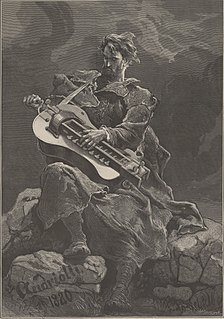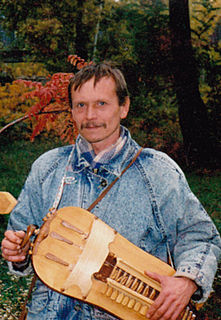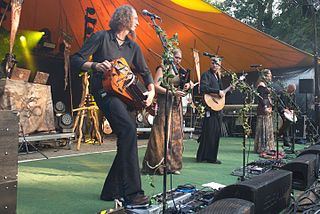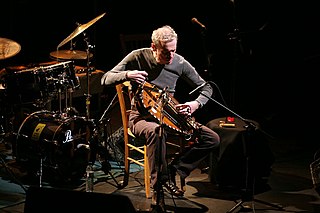French musician Valentin Clastrier (born 1947) is one of the few performers in the world specializing in contemporary music for the hurdy-gurdy; before Clastrier, the instrument was used primarily in the performance of European Medieval and folk musics.
He began his career as a guitarist, and was introduced to the hurdy-gurdy in 1970. His instrument has 27 strings rather than the conventional six. Since 2006 Clastrier works together with Wolfgang Weichselbaumer on a new prototype.
Clastrier's strikingly original compositions for the instrument (in both acoustic and electroacoustic versions) have been recorded, in collaboration with other creative European musicians (including tubist and serpent player Michel Godard, accordionist Jean-Louis Matinier, saxophonist/clarinetists Michaël Riessler and Louis Sclavis, and percussionists Gérard Siracusa and Carlo Rizzo).
Medieval metal is a subgenre of folk metal that blends heavy metal music with medieval folk music. Medieval metal is mostly restricted to Germany where it is known as Mittelalter-Metal or Mittelalter-Rock. The genre emerged from the middle of the 1990s with contributions from Subway to Sally, In Extremo and Schandmaul. The style is characterised by the prominent use of a wide variety of traditional folk and medieval instruments.

The hurdy-gurdy is a stringed instrument that produces sound by a hand-crank-turned, rosined wheel rubbing against the strings. The wheel functions much like a violin bow, and single notes played on the instrument sound similar to those of a violin. Melodies are played on a keyboard that presses tangents—small wedges, typically made of wood—against one or more of the strings to change their pitch. Like most other acoustic stringed instruments, it has a sound board and hollow cavity to make the vibration of the strings audible.
The best known musician from the Occitan region of Limousin is probably the piper Eric Montbel, a former member of such bands as Lo Jai, Le Grand Rouge, and Ulysse; he plays the chabreta, or Limousin bagpipe. Along with him and other pipers, the region is known for Corrèze's distinct violin tradition as well as the hurdy-gurdy. The fife is also popular

The viola organista is a musical instrument designed by Leonardo da Vinci. It uses a friction belt to vibrate individual strings, with the strings selected by pressing keys on a keyboard. Leonardo's design has intrigued instrument makers for more than 400 years, but though similar instruments have been built, no extant instrument constructed directly from Leonardo's incomplete designs is known. Sometimes it is mistakenly referred to as the harpsichord viola, which is a different instrument.

A Kobzar was an itinerant Ukrainian bard who sang to his own accompaniment, played on a multistringed bandura or kobza.

As Europe experienced a wave of roots revivals in the 1950s and 1960s, France found its regional culture reviving traditional music. Brittany, Limousin, Gascony, Corsica and Auvergne were among the regions that experienced a notable resurgence in the popularity of folk music. Traditional styles of music had survived most in remote areas, such as the island of Corsica and mountainous Auvergne, as well as the more nationalist lands of the Basques and Bretons.

The lirnyk were itinerant Ukrainian musicians who performed religious, historical and epic songs to the accompaniment of a lira, the Ukrainian version of the hurdy-gurdy.

Ralph Burns Kellogg, also known as Ethan James, was a musician, record producer, and recording engineer best known for his work on the Minutemen's seminal album Double Nickels on the Dime. He also produced and engineered albums for Black Flag, The Bangles, Rain Parade, Dos, and many others. Many of these recordings were undertaken at Radio Tokyo Studio, the recording facility he founded in the early 1980s.

Louis Sclavis is a French jazz musician. He performs on clarinet, bass clarinet, and soprano saxophone in a variety of contexts, including jazz and free jazz.

Nicolas Chédeville was a French composer, musette player and musette maker.

The lira, or relia, is a Ukrainian variant of the hurdy-gurdy, an instrument which can trace its history back to the 10th century. Regarding the origins of the lira in the region there are two schools of thought:

"Hurdy Gurdy Man" is a song by the Scottish singer-songwriter Donovan. It was recorded in April 1968 and released the following month as a single. The song gave its name to the album The Hurdy Gurdy Man, which was released in October of that year in the United States. The single reached number 5 on the Billboard Hot 100 in the US and number 4 on the UK Singles Chart.

Faun is a German band that was formed in 1998 and plays pagan folk, darkwave, and medieval music. The originality of their music style is that it falls back to "old" instruments, and the singing is always the center of attention. The vocals are performed in a variety of languages, including German, English, Latin, Greek, and Scandinavian languages. Their instruments include Celtic harp, Swedish nyckelharpa, hurdy-gurdy, bagpipes, cittern, flutes, and many others.
The following recordings and films feature music played on the hurdy-gurdy.

Dominique Regef is a French improvisor, composer, and musician specializing in stringed instruments: the cello, the rebec, the vièle à archet, and the Rajasthan dilruba. Dominique Regef is recognized as an exceptional soloist on the hurdy-gurdy; he is known for surprising and moving audiences with his sound on the instrument. His concerts, be it a solo recital or a small group performance, shock listeners from all over the world with their originality and their strength. He has performed in several well-known music festivals, including the International Baroque Music Festival, the Jazz à Luz festival and the Grenoble Jazz Festival. He is cited as one of the best examples of modern hurdy-gurdy playing.
Hållbus Totte Mattson is a multi-instrumentalist folk musician from Dalarna, Sweden. Mattson's instruments include the lute, baroque lute, mandora, bass mandora, hummel, classical guitar, baroque guitar Mora-oud, accordion, Swedish dulcimer, hurdy-gurdy and vocals.
Ben Grossman is a Canadian hurdy-gurdy player, percussionist, composer and improviser. He performs both as a soloist and as part of various ensembles. Ben's work is featured on over 80 CDs. He has also been recorded for film soundtracks, radio dramas, as well as for television shows and commercials.

Rémy Couvez is a French composer and viellist, a musician who plays the hurdy-gurdy.

The Hurdy-Gurdy Player is an oil on canvas painting by Georges de La Tour. The artist neither signed nor dated it, but it was produced in the first phase of his career, probably between 1620 and 1625. It is also known as The Hurdy-Gurdy Player in a Hat or The Hurdy-Gurdy Player with a Fly. It is now in the Musée d'Arts de Nantes.